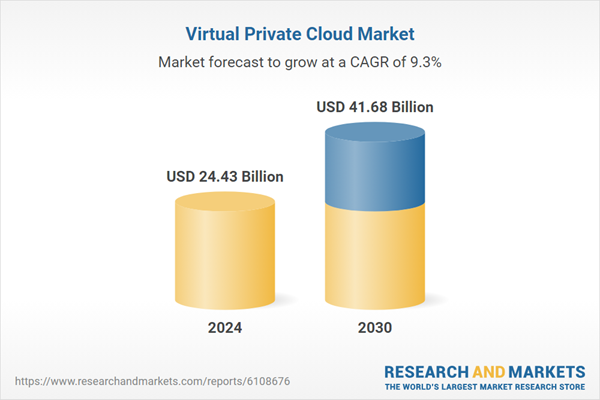Free Webex Call
The Virtual Private Cloud Market was valued at USD 24.43 Billion in 2024, and is expected to reach USD 41.68 Billion by 2030, rising at a CAGR of 9.31%. A Virtual Private Cloud (VPC) refers to a logically isolated section within a public cloud infrastructure that enables enterprises to operate securely while retaining granular control over networking, storage, and computing resources. Speak directly to the analyst to clarify any post sales queries you may have.
10% Free customizationThis report comes with 10% free customization, enabling you to add data that meets your specific business needs.
This architecture allows organizations to run applications, manage sensitive data, and integrate with other systems within a protected environment - while still leveraging the elasticity and cost efficiency of the public cloud. As enterprises increasingly shift from on-premise infrastructure to cloud-native solutions, VPCs offer a balanced approach by combining advanced security measures with the scalability required to support evolving digital business needs. The market is growing steadily as more organizations seek secure and compliant cloud environments that support hybrid IT strategies and regulatory requirements.
Key Market Drivers
Escalating Data Security and Compliance Demands
Enterprises are facing growing pressure to comply with a broad spectrum of data protection regulations - including GDPR, HIPAA, and industry-specific security standards - which mandate strong governance over sensitive data. Virtual private clouds offer a highly secure and isolated environment within public cloud infrastructure, making them an attractive option for businesses handling confidential customer data, intellectual property, and mission-critical workloads. VPCs support robust security configurations such as private networking, encrypted data flows, and controlled access policies. This enables organizations transitioning from legacy systems to cloud environments to adopt a scalable yet secure infrastructure, meeting both internal IT governance standards and external compliance mandates.Key Market Challenges
Complexity of Network Configuration and Management
While virtual private clouds offer high levels of customization and security through advanced networking features, they also introduce substantial setup and maintenance complexities. Enterprises must design detailed network architectures, configure subnets and routing policies, and ensure secure service integration using VPNs, firewalls, and access control mechanisms. Managing these elements, especially across multi-cloud or hybrid environments, demands specialized technical expertise. Many organizations struggle to align these configurations with their legacy infrastructure, increasing the risk of performance bottlenecks or security gaps due to misconfiguration. These operational challenges often delay implementation timelines and may hinder scalability efforts.Key Market Trends
Rise of Hybrid Cloud Adoption in Enterprise Strategy
The evolution of enterprise IT strategies is increasingly centered around hybrid cloud models, with virtual private clouds playing a pivotal role. VPCs provide the security and control necessary for hosting sensitive applications while enabling integration with public cloud resources for scalable computing needs. This hybrid approach allows organizations to optimize performance, maintain compliance with data localization laws, and manage infrastructure more flexibly. Enterprises are segmenting workloads based on sensitivity and operational demand, with VPCs used to create secure zones for core processes while leveraging public cloud environments for innovation, analytics, or peak-load handling. This trend is driving sustained investment in VPC infrastructure across industries.Key Market Players
- IBM Corporation
- Microsoft Corporation
- SAP SE
- Oracle Corporation
- Cisco Systems, Inc.
- Huawei Technologies Co., Ltd.
- Salesforce, Inc.
- Dell Technologies Inc.
Report Scope:
In this report, the Global Virtual Private Cloud Market has been segmented into the following categories, in addition to the industry trends which have also been detailed below:Virtual Private Cloud Market, By Service Model:
- Infrastructure as a Service
- Platform as a Service
- Software as a Service
Virtual Private Cloud Market, By Deployment:
- Public Virtual Private Cloud
- Private Virtual Private Cloud
- Hybrid Virtual Private Cloud
Virtual Private Cloud Market, By End User:
- BFSI
- Healthcare
- Government
- IT and Telecom
- Retail
- Others
Virtual Private Cloud Market, By Region:
- North America
- United States
- Canada
- Mexico
- Europe
- Germany
- France
- United Kingdom
- Italy
- Spain
- Asia Pacific
- China
- India
- Japan
- South Korea
- Australia
- Middle East & Africa
- Saudi Arabia
- UAE
- South Africa
- South America
- Brazil
- Colombia
- Argentina
Competitive Landscape
Company Profiles: Detailed analysis of the major companies present in the Global Virtual Private Cloud Market.Available Customizations:
With the given market data, the publisher offers customizations according to a company's specific needs. The following customization options are available for the report.Company Information
- Detailed analysis and profiling of additional market players (up to five).
This product will be delivered within 1-3 business days.
Table of Contents
1. Solution Overview
2. Research Methodology
3. Executive Summary
5. Global Virtual Private Cloud Market Outlook
6. North America Virtual Private Cloud Market Outlook
7. Europe Virtual Private Cloud Market Outlook
8. Asia Pacific Virtual Private Cloud Market Outlook
9. Middle East & Africa Virtual Private Cloud Market Outlook
10. South America Virtual Private Cloud Market Outlook
11. Market Dynamics
12. Market Trends and Developments
13. Company Profiles
Companies Mentioned
- IBM Corporation
- Microsoft Corporation
- SAP SE
- Oracle Corporation
- Cisco Systems, Inc.
- Huawei Technologies Co., Ltd.
- Salesforce, Inc.
- Dell Technologies Inc.
Table Information
| Report Attribute | Details |
|---|---|
| No. of Pages | 185 |
| Published | July 2025 |
| Forecast Period | 2024 - 2030 |
| Estimated Market Value ( USD | $ 24.43 Billion |
| Forecasted Market Value ( USD | $ 41.68 Billion |
| Compound Annual Growth Rate | 9.3% |
| Regions Covered | Global |
| No. of Companies Mentioned | 8 |









